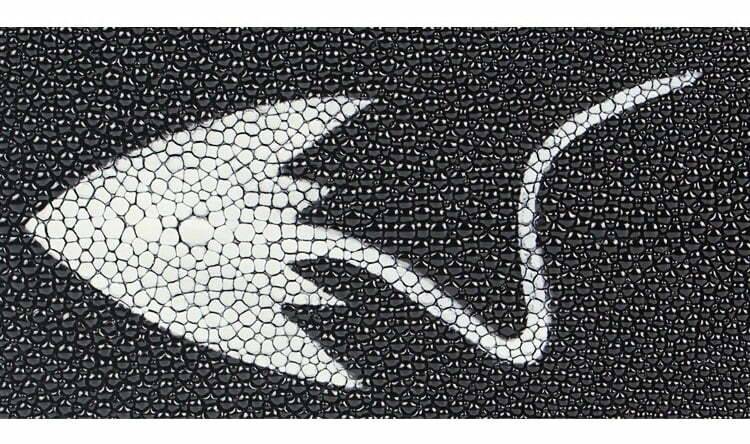Buyers Guide
Exotic Stingray Skin and Leathercraft Industry
What is stingray skin?
Stingray skin, also known as shagreen, is the upper portion of certain species of shark and ray used in leathercraft.
The Indo-pacific is a global centre for intense elasmobranch (i.e., sharks, rays and skates) fishing. Stingrays are widespread in the region, and the fishery sector plays an important role in the economy of adjacent low-income countries, which rely on the fishing sector for food security, protein, income and employment.
Today, the skins we buy to make wallets, watch straps, wrapped boxes and small bags, are mostly from farmed stingrays in Asia. In particular, Thailand.

Of all exotic leathers, stingray is often the most underrated. It is highly durable (25 times more durable than cowhide leathers) and has a unique supple texture. This leather is one of the most durable skins and is widely available. It can be textured to be bumpy or flat and painted in any color in a large number of possibilities. Under no threat of extinction, this fish provides a useful protein food to many regions throughout Southeast Asia.
The skin has a fibrous flesh side made up of collagen fibres, much like regular leather, but that’s where the similarities end.
The surface is made up of small spheres, sometimes called pearls. They are larger in the centre of the skin and smaller on the outer edges.
Each tiny sphere is made up of a hard substance called dentin, with an even harder outer coating of enamel. Very similar to your teeth.
The stingray uses this tooth like outer armour as a defence system against attack, which is why the spheres only cover the area of the ray around the vital organs.
During processing, the soft meaty exterior wings are removed (for food consumption), and the upper layer of shagreen is sent off for tanning.
This is why stingray skin isn’t consistent with the shape of a live stingray.
Most stingray skins are chrome tanned which allows the skin to remain strong and flexible for product manufacture.
-
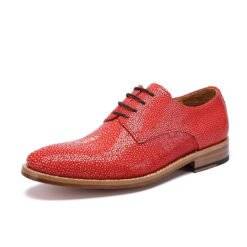 Genuine Stingray Leather Mens Formal Lace Up Shoes Business Oxford Dress ShoesProduct on sale$660.00
Genuine Stingray Leather Mens Formal Lace Up Shoes Business Oxford Dress ShoesProduct on sale$660.00 -
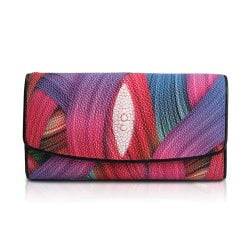 Stingray Leather Women Long Clutch Wallet Flowers PatternProduct on sale$149.00
Stingray Leather Women Long Clutch Wallet Flowers PatternProduct on sale$149.00 -
 Real Stingray Skin Women Long Clutch Wallet with ChainProduct on sale$269.00
Real Stingray Skin Women Long Clutch Wallet with ChainProduct on sale$269.00 -
 Stingray Wallet Mens Sleek Stingray Skin WalletProduct on sale$79.99
Stingray Wallet Mens Sleek Stingray Skin WalletProduct on sale$79.99 -
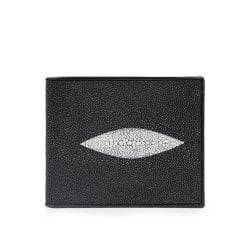 Genuine Stingray Leather Bi-Fold Wallet BlackProduct on sale$79.99 – $86.99
Genuine Stingray Leather Bi-Fold Wallet BlackProduct on sale$79.99 – $86.99 -
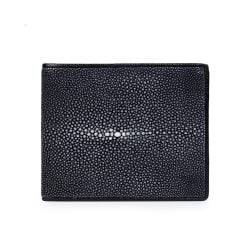 Men’s Polished Stingray Leather Wallet BlackProduct on sale$89.00
Men’s Polished Stingray Leather Wallet BlackProduct on sale$89.00 -
 Women Genuine Stingray Skin Long WalletProduct on sale$139.00 – $159.00
Women Genuine Stingray Skin Long WalletProduct on sale$139.00 – $159.00 -
 Genuine Stingray Leather Long Tri-Fold WalletProduct on sale$139.00
Genuine Stingray Leather Long Tri-Fold WalletProduct on sale$139.00 -
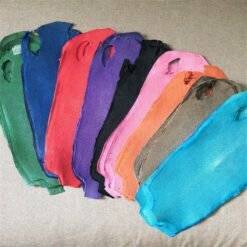 Genuine Stingray Skin Real Shagreen Leather Soft Hide PeltProduct on sale$56.98
Genuine Stingray Skin Real Shagreen Leather Soft Hide PeltProduct on sale$56.98
Finishes and Grading
There are two types of finishing for shagreen.
One is simply left un-sanded before being dyed a particular colour. This gives a caviar like look to the finished skin. The other finish is sanded.
Sanding is usually done after the dying process where a machine sands away a portion of the surface exposing the un-dyed dentin underneath the enamel. Some finishes are dyed after sanding if a more uniform colour is required.
This will provide a uniform thickness across the skin which is also desirable for book binding, small cases, boxes, cabinets, humidors and wherever a raised effect is undesirable.
Finally, the sanded skin is put through a machine which imparts a polished finish that catches the light, providing a striking appearance.
Caviar finish stingray have bumps or beads that have not been altered from nature. Stingray skins have a unique diamond shape white eye/crown in the center of each skin which is actually a calcium deposit. Each skin has two breathing holes located at the upper portion of each skin which is not considered in the grading.
Stingray skins are only graded below the two breathing holes. Any area in-between the breathing holes are not considered. Stingray skins are measured from the widest area across. Sanded or polished stingray skins are commonly referred to as shagreen and are used in furniture production, wall coverings, and those interested in luxurious finished products. Sanding stingray skins will increase the price roughly 30% from the caviar finish, this is due to the fact that 30% of the skins will not adhere to the sanding and must be graded down or discarded.
About Stingrays
Most people don’t know that Stingrays are fish. In fact, many people take excursions around the reefs of Bora Bora and Morea to swim with giant rays and actually hand feed them.
All Stingrays, despite their size differences, are equipped with long, flexible whip-like tails. There are usually one or two sharp spines on the tail near the middle. These spines have sharp teeth along their edges making them barb-like, much like a fishing hook. At the base of these teeth are small glands that contain poison pockets capable of causing wounds nearly as painful and dangerous as a snake bite. Stingrays swing their tails upward to defend against predators.
Stingrays live on the sandy or muddy bottoms of all warm, shallow parts of the oceans and bays. In South America, they can be found in the rivers that flow into the Atlantic Ocean. Stingrays also live as far as 2,000 miles above the mouth of the Amazon River.

